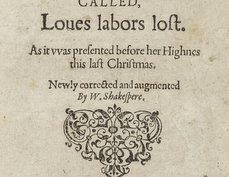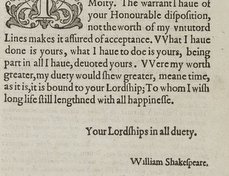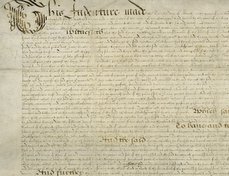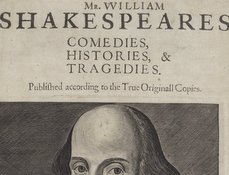Terms of use
Images that are under Folger copyright are licensed under a Creative Commons Attribution-ShareAlike 4.0 International License. This allows you to use our images without additional permission provided that you cite the Folger Shakespeare Library as the source and you license anything you create using the images under the same or equivalent license. For more information, including permissions beyond the scope of this license, see Permissions. The Folger waives permission fees for non-commercial publication by registered non-profits, including university presses, regardless of the license they use. For images copyrighted by an entity other than the Folger, please contact the copyright holder for permission information.
Document-specific information
Title: An historical compendium of the mutability of fortune and honour, etc. [manuscript]
Date: ca. 1600
Repository: Folger Shakespeare Library, Washington, DC, USA
Call number and opening: V.a.135, p. 60
View online bibliographic record
David McInnis, "An Historicall Compendium of the Mutabilitie of FORTUNE & HONOUR: early manuscript allusion to Hamlet," Shakespeare Documented, https://doi.org/10.37078/741.
Folger Shakespeare Library, V.a.135. See Shakespeare Documented, https://doi.org/10.37078/741.
A previously unnoticed reference to Hamlet – possibly one of the earliest in existence – is in a manuscript held by the Folger Shakespeare Library. In An Historicall Compendiu[m] of the Mutabilitie of FORTUNE & HONOUR &c (MS V.a.135), the unknown author begins a final section on “Honour,” after discussing such topics as “Fortune” and “Fame.” A key example in this section seems to be Shakespeare’s Hamlet: “So farr is Death from being held any Evill to perfect Resolutions, as the Revengfull Dane, in the Tragedie, would not take his Uncles life while he made his Deuotions: Art thou then Imprisoned?” (p. 60). This corresponds to the moment in Act 3, scene 3, lines 77-84 of Hamlet, when the prince spies his uncle seemingly at prayer, and declines to kill him:
Now might I do it <pat>, now he is a-praying,
And now I'll do’t.
And so he goes to heaven,
And so am I <revenged>. That would be scanned:
A villain kills my father, and for that,
I, his sole son, do this same villain send
To heaven.
Why, this is <hire> and <salary,> not revenge.
Most of the book’s examples are Classical in nature: “Hercules” and “the Labours he overcame” (p. 47), Damocles (here called “the Philosopher”), who was “placed vpon a Bed of State, in the middst of all his Pleasures and Glories” but had a sword dangling above him, suspended precariously by “a small haire” (p. 47); Alexander, who responded to Darius’s offer “to diuide his Kingdome” with the retort that “the world was no more capable of two Emperors, then the Heauen of Suns” (p. 49); or “The Triumviri” (Antony, Augustus and Lepidus), who “became Instruments of Ruin to themselues” (p. 49). Amongst the discussion of flattery leading to betrayal, there is a rare Biblical example: “What were the Tragedies wrought by Salom in Herod’s House”? (p. 52). The Hamlet allusion follows on from a Classical contemplation of what comes after death: “Canius may then constantly meditate the Sense of Separation betweene Soule & Bodie, and hartily returne the Emperour thanks” (Canius Julius famously had no fear of his imminent execution, for the chance it offered to find out if the soul would continue after the body’s death; he promised to return if it did). Hamlet, though, is unique amongst the examples as a reference to English drama.
Hamlet was first printed in 1603, and had reached a third edition by 1611. Seymour de Ricci’s Census of Medieval and Renaissance Manuscripts (1935) entry for the title ascribes a date of ca.1600 to the manuscript. If this were accurate, the Hamlet allusion would be of considerable interest as one of the very earliest recorded. The internal evidence does not offer any assistance with dating, but the watermark is consistent with an early 17th century date: a Strasburg lily (fleur-de-lis in a crowned shield) with a pendant 4 (backwards) and the initials WR (probably Wendelin Riehel), which is found on paper dating from the 1590s to the early 17th century (for example, see Heawood 1721a and Gravell SLD.014.1). Unfortunately, the manuscript is anonymous and does not contain any prefatory material or dedications which might identify the author or their patron.
David McInnis brought the FORTUNE & HONOUR manuscript and the allusion to Hamlet to light while researching representations of Fortune at the Folger Shakespeare Library in 2013, as preparation for his Revels Plays edition of Thomas Dekker’s Old Fortunatus (1600). A stenciled crest with the inscription “Sir T. P. / Middle Hill / 2604” on the front free endpaper confirms that it was once part of the collection of manuscripts owned by Sir Thomas Phillipps (1792-1872) (see Munby 31). A shelfmark (1347.283.) has been added below the crest in pencil, as is occasionally the case with Phillipps manuscripts. The manuscript also bears the signature of another former owner, “John Peirse”, on the rear free endpaper; Seymour de Ricci suggests this was in the 18th century (1:282). De Ricci further notes that it was sold to Phillipps by Thorpe in 1824, and passed from Phillipps to Henry Clay Folger in 1896. It was lot 16604 in this final sale, and this number is recorded on the fixed endpaper at the front of the book. The lot number from the Thorpe sale (5333) is cancelled but still visible on the free endpaper at the front.
60.
with out-ward Accidents, having such Powers to with-stand
them? Is thy Life threatned? Imagine thou hast Lived the
time of thy appointment, and, knowing thou art to repay
it (as something borrowed) in its time, It cannot molest
thee, to surrender now, that which was alwais to be requi=
=red: Omnia leuiora accidunt expectantibus: Where Death is
made no Stranger in Life, Life will seeme no Stranger there,
in Death. Canius may then constantly meditate the Sence
of Seperation between Soule & Bodie, and hartely returne the
Emperour thancks for such a Curtesie: Soe farr is Death
from being held any Evill to perfect Resolutions, as the Reveng=
=full Dane, in the Tragedie, would not take his Vncles life while
he made his Deuotions: Art thou then Imprisoned? Take the
benefit of the Time and that Advantage, as thou art farther
from others, the neerer thy self entertaine that sweet Company
thy Soule; Cast before her the Vanities thou hast past. dis=
course with her the Excellency of her Matter: the Subtletie of
her Being: the Extent of her Knowledge; the Swiftnes of her
Imagination, and from thence Collect Thoughts worthie of her
Which is of a heauenly Constitution, and doth not participate of
any thing so base as Earth and Element: In this thou canst
not be lymitted or restrayned by the power of an other Corpora
obnoxia sunt et ascripta, Dominus mens quidem suj iuris quae
adeo libera et vaga est vt ne abhoc quidem Carcere cui in=
=clusa est teneri queat qui minus impetu suo Vtatur et ingen=
=tia
Written by David McInnis
Sources
Edward Heawood, Watermarks, Mainly of the 17th and 18th Centuries (Hilversam, Holland: Paper Publications Society, 1950).
A. N. L. Munby, ed. The Phillipps Manuscripts: Catalogus Librorum Manuscriptorum in Bibliotheca D. Thomae Phillipps, bt (London: Holland Press, 1968).
Seymour de Ricci with W. J. Wilson, Census of Medieval and Renaissance Manuscripts in the United States and Canada (New York: The H. W. Wilson Company, 1935).
Daniel W. Mosser, Ernest W. Sullivan II, with Len Hatfield and David H. Radcliffe. The Thomas L. Gravell Watermark Archive. 1996-. 2016-05-10 <www.gravell.org>
Last updated June 8, 2020










